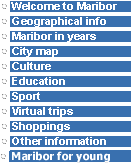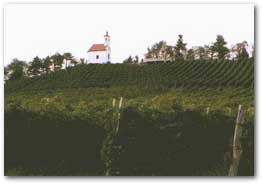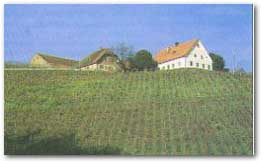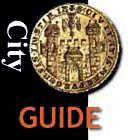

 One can reach the town limits of Maribor without difficulty. Strolls
through the Town Park are quite enjoyable. On its northeastern edge there
is a path leading up to Piramida Hill; it can be climbed in ten minutes
or so. At one time there was a castle, which gave the city its name, at
the top of Piramida Hill. Now only a memorial chapel remains, built on the
site of the former pyramid and constructed out of the castle's ruins. Following
the promenade through the park, one comes to the restaurant Pri treh
ribnikih (At the Three Ponds). The area is attractively landscaped.
One can reach the town limits of Maribor without difficulty. Strolls
through the Town Park are quite enjoyable. On its northeastern edge there
is a path leading up to Piramida Hill; it can be climbed in ten minutes
or so. At one time there was a castle, which gave the city its name, at
the top of Piramida Hill. Now only a memorial chapel remains, built on the
site of the former pyramid and constructed out of the castle's ruins. Following
the promenade through the park, one comes to the restaurant Pri treh
ribnikih (At the Three Ponds). The area is attractively landscaped.

 From there one can stroll towards Ribnisko
selo, or take a 20 minute walk to Kalvarija
(Calvary Hill). At the top is the Chapel of St.
Barbara, built in 1681 by Maribor citizens, to commemorate the lifting of
the plague that had devastated the town a year before. Going down from Calvary
Hill one passes several small, memorial chapels on the road back to the
Town Park.
From there one can stroll towards Ribnisko
selo, or take a 20 minute walk to Kalvarija
(Calvary Hill). At the top is the Chapel of St.
Barbara, built in 1681 by Maribor citizens, to commemorate the lifting of
the plague that had devastated the town a year before. Going down from Calvary
Hill one passes several small, memorial chapels on the road back to the
Town Park.
 It is a very pleasant walk along the river bank, close to the renovated
shops and restaurants. One reaches the river bank either by descending the
stone staircase at the old bridge or walking through one of the many narrow
little streets leading to the Drava from Glavni trg (Main Square) or Koroska
cesta.
It is a very pleasant walk along the river bank, close to the renovated
shops and restaurants. One reaches the river bank either by descending the
stone staircase at the old bridge or walking through one of the many narrow
little streets leading to the Drava from Glavni trg (Main Square) or Koroska
cesta.
 Along the river, the path winds from Lent
to Mariborski otok (Maribor Island), with its swimming facilities. The road
then leads up to the village of Kamnica, where the walker can set off north
to St. Urban, a small village with a local church (595 m). Maribor is in
the immediate vicinity of the Pohorje range. From the valley in Zgornje
Radvanje there is a brisk climb of about an hour and a half to Hotel Bellevue
or one can take the cable lift, a ride of some fifteen minutes. The upper
station of the cable lift provides a pleasant stroll along the road or through
forest paths to the lookout tower (1148 m), which affords a panoramic view
of Maribor, the Drava valley, Kozjak, the Slovenske gorice vineyard hills,
and the Drava Field up to Donacka gora (the Donacka Mountain) The surrounding
areas have many holiday resorts (called "pocitniski dom")
and mountain cottages ("koca"): Zeleznicarski dom (1046
m); Postarski dom (890 m); Planinski dom Glazuta (1080 m); Pajkov dom (1110
m); Dom Planika (890 m); Ruska koca (1250 m); Zarja (1200 m); Pocitniski
dom Jelka (958 m); Dom na Peckah (720 m); Dom Milosa Zidanska (1030 m);
Pocitniski dom Gradis (1000 m); and Mariborska koca (1080m). All these resorts
and cottages are accessible by automobile. The Pohorje Mountain range is
spanned by a number of scenic forest roads, leading to Hoce, Slovenska Bistrica,
Ruse, and Podvelka. The northern Slovene arterial road runs through Maribor.
Through the picturesque Drava valley, extending to Crna (89 km),
the road links the city with Carinthia; to the east, with Lendava (92
km), which is almost on the Slovenian-Hungarian border. Interesting stopping
off places would be the wine growing Prlekija region (Ormoz, Ljutomer,
Jeruzalem, Kapela); the spas, Slatina Radenci and Banovci;
and the thermal springs in Moravci, across the Mura River. In autumn,
these areas offer good hunting in addition to the many other tourist attractions.
Following the road to Zagreb one can also take a rewarding drive to Ptuj
(25 km), which is in itself a veritable museum and, in fact, has been officially
so designated. It is rich in historical and cultural treasures. It also
has a spa. Going south, one heads towards Celje (61 km) and Ljubljana
(136 km). After passing Slovenska Bistrica, the road through Poljcane
leads to the world famous spa Rogaska Slatina (47 km).
Along the river, the path winds from Lent
to Mariborski otok (Maribor Island), with its swimming facilities. The road
then leads up to the village of Kamnica, where the walker can set off north
to St. Urban, a small village with a local church (595 m). Maribor is in
the immediate vicinity of the Pohorje range. From the valley in Zgornje
Radvanje there is a brisk climb of about an hour and a half to Hotel Bellevue
or one can take the cable lift, a ride of some fifteen minutes. The upper
station of the cable lift provides a pleasant stroll along the road or through
forest paths to the lookout tower (1148 m), which affords a panoramic view
of Maribor, the Drava valley, Kozjak, the Slovenske gorice vineyard hills,
and the Drava Field up to Donacka gora (the Donacka Mountain) The surrounding
areas have many holiday resorts (called "pocitniski dom")
and mountain cottages ("koca"): Zeleznicarski dom (1046
m); Postarski dom (890 m); Planinski dom Glazuta (1080 m); Pajkov dom (1110
m); Dom Planika (890 m); Ruska koca (1250 m); Zarja (1200 m); Pocitniski
dom Jelka (958 m); Dom na Peckah (720 m); Dom Milosa Zidanska (1030 m);
Pocitniski dom Gradis (1000 m); and Mariborska koca (1080m). All these resorts
and cottages are accessible by automobile. The Pohorje Mountain range is
spanned by a number of scenic forest roads, leading to Hoce, Slovenska Bistrica,
Ruse, and Podvelka. The northern Slovene arterial road runs through Maribor.
Through the picturesque Drava valley, extending to Crna (89 km),
the road links the city with Carinthia; to the east, with Lendava (92
km), which is almost on the Slovenian-Hungarian border. Interesting stopping
off places would be the wine growing Prlekija region (Ormoz, Ljutomer,
Jeruzalem, Kapela); the spas, Slatina Radenci and Banovci;
and the thermal springs in Moravci, across the Mura River. In autumn,
these areas offer good hunting in addition to the many other tourist attractions.
Following the road to Zagreb one can also take a rewarding drive to Ptuj
(25 km), which is in itself a veritable museum and, in fact, has been officially
so designated. It is rich in historical and cultural treasures. It also
has a spa. Going south, one heads towards Celje (61 km) and Ljubljana
(136 km). After passing Slovenska Bistrica, the road through Poljcane
leads to the world famous spa Rogaska Slatina (47 km).
 In the immediate vicinity of Maribor there
are two points of interest that perhaps are not well known even to local
residents. The first is the sconce Postela. In prehistoric times
there was an Illyric - and later on Celtic - settlement, surrounded by a
protective rampart. The latter is well preserved to this day and shows evidence
that it once enclosed a 315 m-long and 240 m-wide settlement, with enough
space for 60 homes, or about 300 inhabitants. Also of much interest is a
deep cistern cut into the rock ("crna mlaka", "The Black
Puddle"). The contours of the former fortified settlement are most
noticeable in late autumn, when the trees have shed their leaves. Immediately
below Postela is Lepa ravna, a former Postela burial ground, with mound
graves still visible. Postela can be reached on foot following the Slovene
mountain transversal trail. Beginning at Spodnje Radvanje (take local bus
number 6), at the "Monument to the Dead Hostages" the trail ascends
across Postela. From Razvanje one can also drive to Postela. The road leads
to the settlement Pri Habakuku; from there we can stroll to the Postela
sconce.
In the immediate vicinity of Maribor there
are two points of interest that perhaps are not well known even to local
residents. The first is the sconce Postela. In prehistoric times
there was an Illyric - and later on Celtic - settlement, surrounded by a
protective rampart. The latter is well preserved to this day and shows evidence
that it once enclosed a 315 m-long and 240 m-wide settlement, with enough
space for 60 homes, or about 300 inhabitants. Also of much interest is a
deep cistern cut into the rock ("crna mlaka", "The Black
Puddle"). The contours of the former fortified settlement are most
noticeable in late autumn, when the trees have shed their leaves. Immediately
below Postela is Lepa ravna, a former Postela burial ground, with mound
graves still visible. Postela can be reached on foot following the Slovene
mountain transversal trail. Beginning at Spodnje Radvanje (take local bus
number 6), at the "Monument to the Dead Hostages" the trail ascends
across Postela. From Razvanje one can also drive to Postela. The road leads
to the settlement Pri Habakuku; from there we can stroll to the Postela
sconce.

 The second place of interest is Princev
vrh, or Meranovo, a country mansion in Vrhov dol 14. It can be
reached on foot from Limbus (5 km from Maribor towards Ruse on the right
bank of the Drava), or by car along the 3 km road going south. The mansion
stands in the midst of vineyards under the northern slope of the eastern
Pohorje Mountain. In 1822 it was bought by the Hapsburg Archduke Johann
(Erzherzog Johann), brother of the Austrian King Franz I. Archduke Johann
spent a long period of time there with his wife Ana Plochl, daughter of
the postmaster. His marriage to a woman his social inferior was not taken
kindly by the court. Their son Franz was given the title Meran Count (after
the town Meran, in South Tyrolia); hence also the name of the estate. The
Archduke Johann, who was instrumental in fostering progress in agriculture,
industry, transportation, and the sciences in Styria, had planted a successful
vineyard next to the mansion, thus demonstrating that grapevines can also
productively grow at higher altitudes. He developed the excellent Rhenan
Riesling, and was celebrated for the advance of wine-growing in these parts.
Emperor Franz I, with the Empress, visited his brother at his mansion in
1830, on his way from Ljubljana. There is a plaque on the front of the mansion
to commemorate the event. The mansion, situated among excellent vineyards,
is now being renovated into a resort for tourists.
The second place of interest is Princev
vrh, or Meranovo, a country mansion in Vrhov dol 14. It can be
reached on foot from Limbus (5 km from Maribor towards Ruse on the right
bank of the Drava), or by car along the 3 km road going south. The mansion
stands in the midst of vineyards under the northern slope of the eastern
Pohorje Mountain. In 1822 it was bought by the Hapsburg Archduke Johann
(Erzherzog Johann), brother of the Austrian King Franz I. Archduke Johann
spent a long period of time there with his wife Ana Plochl, daughter of
the postmaster. His marriage to a woman his social inferior was not taken
kindly by the court. Their son Franz was given the title Meran Count (after
the town Meran, in South Tyrolia); hence also the name of the estate. The
Archduke Johann, who was instrumental in fostering progress in agriculture,
industry, transportation, and the sciences in Styria, had planted a successful
vineyard next to the mansion, thus demonstrating that grapevines can also
productively grow at higher altitudes. He developed the excellent Rhenan
Riesling, and was celebrated for the advance of wine-growing in these parts.
Emperor Franz I, with the Empress, visited his brother at his mansion in
1830, on his way from Ljubljana. There is a plaque on the front of the mansion
to commemorate the event. The mansion, situated among excellent vineyards,
is now being renovated into a resort for tourists.
